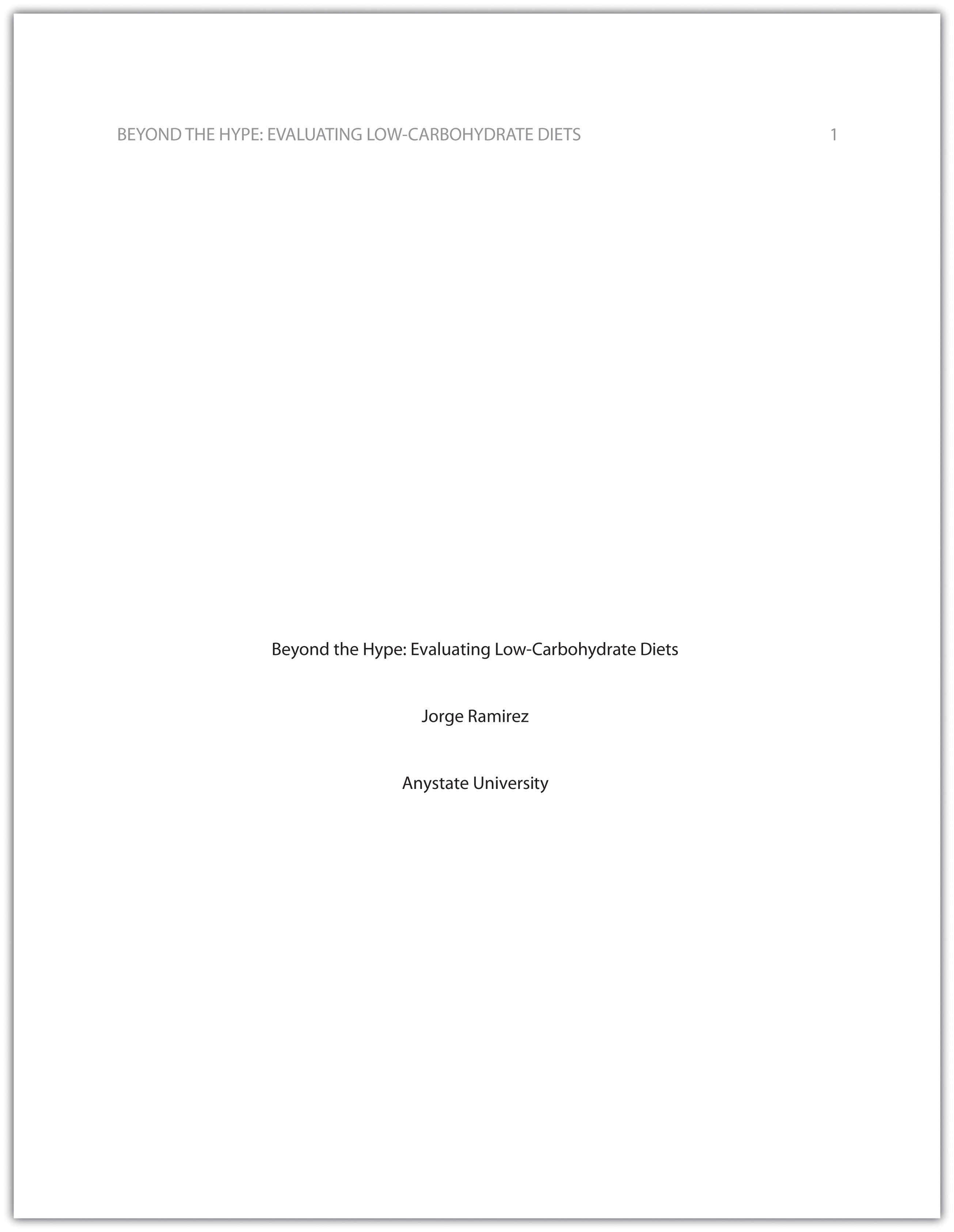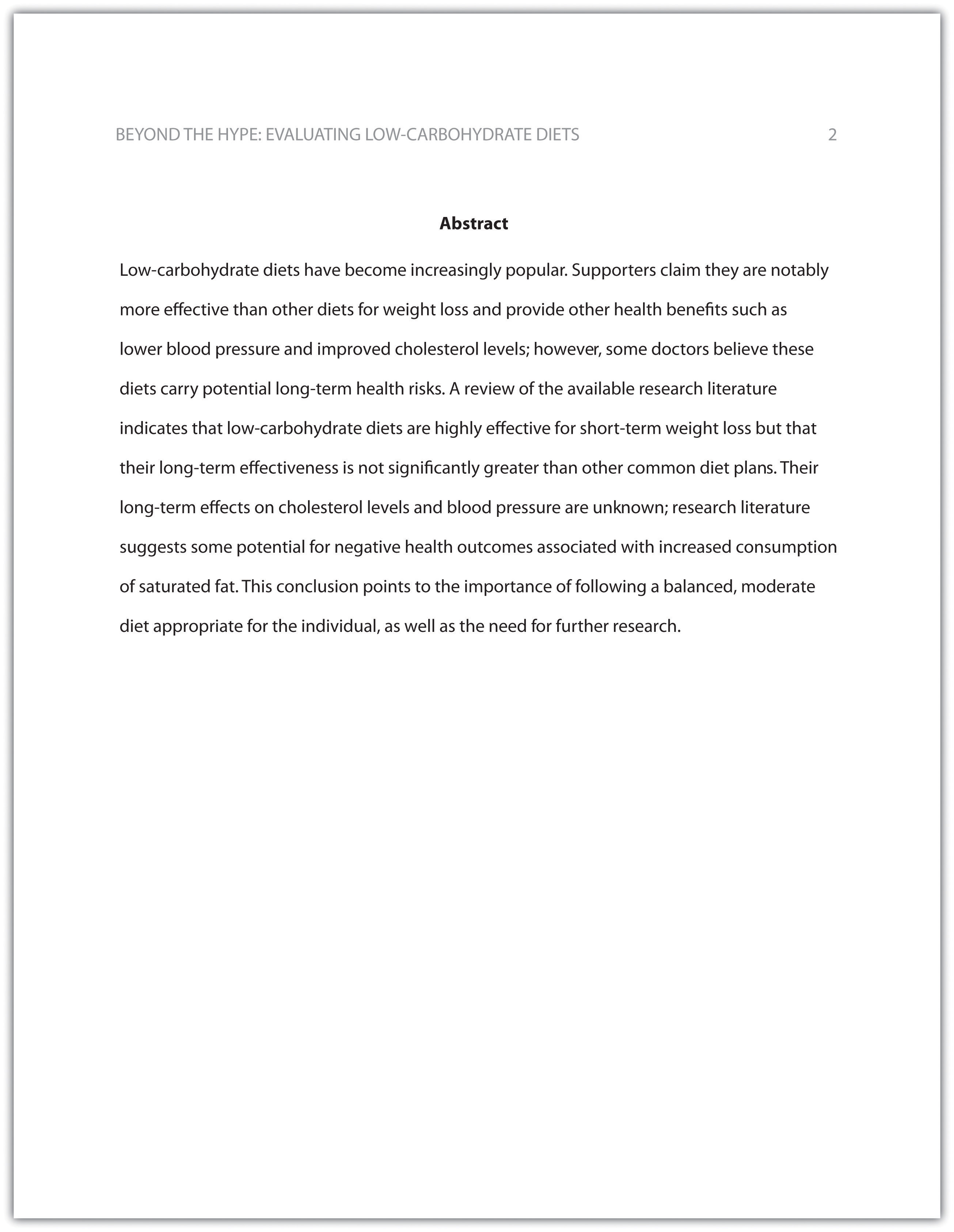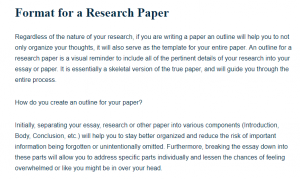
APA is just one of several different styles with its own guidelines for documentation, formatting, and language usage. Depending on your field of interest, you may be exposed to additional styles, such as the following:
The brief citations included in the body of your paper correspond to the more detailed citations provided at the end of the paper in the references section. In-text citations provide basic information—the author’s name, the publication date, and the page number if necessary—while the references section provides more extensive bibliographical information. Again, this information allows your reader to follow up on the sources you cited and do additional reading about the topic if desired.
APA style uses section headings to organize information, making it easy for the reader to follow the writer’s train of thought and to know immediately what major topics are covered. Depending on the length and complexity of the paper, its major sections may also be divided into subsections, sub-subsections, and so on. These smaller sections, in turn, use different heading styles to indicate different levels of information. In essence, you are using headings to create a hierarchy of information.
The specific format of entries in the list of references varies slightly for different source types, but the entries generally include the following information:
In-Text Citations

- Work ahead whenever you can.Chapter 11 “Writing from Research: What Will I Learn?” includes tips for keeping track of your sources early in the research process, which will save time later on.
- Get it right the first time. Apply APA guidelines as you write, so you will not have much to correct during the editing stage. Again, putting in a little extra time early on can save time later.
- Use the resources available to you. In addition to the guidelines provided in this chapter, you may wish to consult the APA website at http://www.apa.org or the Purdue University Online Writing lab at http://owl.english.purdue.edu, which regularly updates its online style guidelines.
- Section headings use centered, boldface type. Headings use title case, with important words in the heading capitalized.
- Subsection headings use left-aligned, boldface type. Headings use title case.
- The third level uses left-aligned, indented, boldface type. Headings use a capital letter only for the first word, and they end in a period.
- The fourth level follows the same style used for the previous level, but the headings are boldfaced and italicized.
- The fifth level follows the same style used for the previous level, but the headings are italicized and not boldfaced.
Another variation is to introduce the author and the source title in your sentence and include the publication date and page number in parentheses within the sentence or at the end of the sentence. As long as you have included the essential information, you can choose the option that works best for that particular sentence and source.
- Your title page
- The abstract you created in Note 13.8 “Exercise 1”
- Correct headers and page numbers for your title page and abstract

As required by the most widespread essay paper format, a good assignment should include an Introduction, Body, and Conclusion:
State the thesis statement and explain why the issue is important.
Writing a research paper is not that difficult providing you know what to start from and what pitfalls you can face. We’ve prepared a short guide to ease this task and make it less challenging. Here you will find tips on how to write a successful research paper format-wise, what sections it is supposed to include, how to choose a good title and reliable sources, and so on. Special attention will be paid to the specifics of research paper format, structure, and related details. Overall, academic writing requires attention to details and a bit of patience, as well as enough time for proofreading every assignment. In simple words, just keep calm and write on!
Before you start writing, make sure you’ve defined the subject. You are to present something new and interesting to your audience, but still, you’d better not select too complicated subjects. After this, you will need to brainstorm the existing literature, as well as pick up sources you are going to refer to when writing. Imagine your thesis is an endpoint, while the paragraphs in your paper are the steps you’re to make to reach it.
How to Write a Research Paper Format
Connect with our top writers and receive a research paper crafted to your needs.
As stated in most research paper guidelines, the main sections are:
Attempting to adhere to college research paper format can be rather challenging. In order to succeed, you should indeed be attentive. The good news is that formatting a research paper is a skill that can be developed, which means that the entire process will require less time and effort in the future.
When you are studying in college or university, you have to write a research paper because it is an integral part of the curriculum. Generally, while preparing this academic work, you will do research on the various technical, scientific or social aspects of some phenomenon and then organize the obtained information. It is not easy. If you have never faced this type of academic writing before, the task may seem complicated or even impractical.
A literature review does not present an original argument. The purpose is to offer an overview of what is known about the topic Ordeer to evaluate the strength of the evidence on that topic. It usually contains a summary, a synthesis, or an analysis of the key arguments in the existing literature.
It has gained greater attention with the advent of Ty
O'Neill Library Main library. Bapst Library Art and architecture. Burns Library Special collections. Educational Resource Center Curriculum collection. Social Work Library Social services collection.
What Are The Three Main Parts Of A Research Report - The Science of Seaweeds | American Scientist

Show AWL words on Paepr page. Show sorted lists of these words. Any words Where Can I Get My Essay Edited For Free you don't know. Use the website's built-in dictionary to look them up!
Three types of order for the research paper are - authentic researches at reasonable prices available here will turn your studying into pleasure Stop receiving. Analytical Research Paper. In an analytical research paper you pose a question and then collect relevant data from other researchers to analyze their different.
An APA-style paper includes the following sections: title page, abstract, introduction, method, results, discussion, and references. Different types of information about your study are addressed in each of the sections, as described below. The title page, abstract, references, table sand figure s should be on their own pages. The entire paper should be written in the past tense, in a point font, double-spaced, and with one-inch margins all around. The introduction of an APA-style paper is the most difficult to write.
In reviewing hypothesis tests, we start first with the general idea. Then, we keep returning to the basic procedures of hypothesis testing, each time adding a little more detail.
An abstract is another important part of a research paper. It contains the objective, the summary, and the goal of a research paper and it should consist of 100 to 500 words. Usually an abstract should summarize the whole research, including its key themes and problems and providing the major conclusions. It should not contain figures and references.
A methodology and framework chapter is a chapter that is included in a large research paper to provide the complete and detailed report of a research process. The methodology should not include the comments of an author not to influence the objectivity of the presentation, as the main aim of this chapter to enable other researches to repeat the procedure of your research step by step and to compare the results. The methodology and framework chapter normally deals with the description of the research subject, methods and tools of the study and methods and tools of the analysis that was used to summarize the final results of the research. However, the results should not be reported in the methodology section as this is the subject of the following chapters.
In the introduction, a writer gives a brief explanation to his/her objective in their paper by listing the key points. The explanation must be brief and interesting enough to arise in a reader of your paper a desire to read further. An introduction should include a thesis statement: it comes to inform of a declaration of a writer’s opinion, which forms the basis of the research paper.
When you are given a research title be sure to identify the level of difficulties before forging ahead with your writing.
Research Paper Abstract
All sources, such as printed books, book chapters, newspaper articles and websites should be properly cited in the research paper writing.
Understand the type of essay to use it in writing your research paper. For instance you could be given a research paper title that requires you to persuade, or argue. How would you do this?
There are several parts that should be included in a research paper: title page, abstract, introduction, methodology chapter, body and conclusion. However, some of these parts may be optional, depending on the type and level of your paper. For example, you most likely will not be asked to write a methodology chapter for a small college paper, and the usage of a title page depends on the style of the paper, for example, APA or MLA.
The parts of a research paper should be clearly connected with each other, that is to say, they should be arranged in the logical order and the paper should be structured in such a way that a reader could easily find all the necessary information there. In fact, the basic outline of a paper is a gradual description of your topic and its illustration by the examples.
A conclusion is a short summary of a paper. Any new information should not be introduced here. Just reaffirm the thesis and bring research paper to a very dramatic close. This is a strategy used by such genuine writing companies as P rof E ssays.com .

You will also want to consider using a literature overview. This is achieved by documenting the literary sources used to support your theories and hypothesis. The topic of your paper and the selected literature should be adjacent.
- The Introduction
- The Body
- The Conclusion
A title page is not essential for a research paper unless specifically requested by your teacher. The MLA Handbook provides a general guideline on writing a research paper and documenting sources. In case of conflict, you should always follow guidelines set down by your teacher.
If a Title Page is a requirement for your assignment, begin on a new page. Use a format preferred by your teacher. Otherwise, center each line and double-space every line on a blank page: name of school (optional), title of paper in upper and lower case, course code, course name (optional), teacher’s name, your first and last name, and date.
How to Format a Research Paper
Follow the same capitalization rules for acronyms as you normally would in writing a text of the essay, e.g. FBI would be all in capitals as it is the acronym for Federal Bureau of Investigations. When using an acronym, especially an uncommon one, you must indicate what the letters stand for at the first occurrence in your essay. Example: The North American Aerospace Defense Command (NORAD) is nearly finished converting from using standard desktop PCs to blade PCs.
Lastly, you will write your Conclusion. The conclusion typically does not offer new information, but rather summarizes the main points addressed in the paper. It is mandatory to also reiterate the thesis statement and mention any future research.
Double-space after the date. On a new line, center the title of your essay. If you have a long title, double-space between lines of the title.

